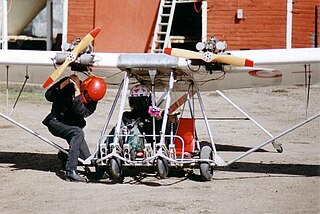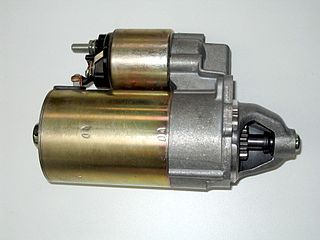 W
WAn air-start system is a power source used to provide the initial rotation to start large diesel and gas turbine engines.
 W
WMany variations of aircraft engine starting have been used since the Wright brothers made their first powered flight in 1903. The methods used have been designed for weight saving, simplicity of operation and reliability. Early piston engines were started by hand, with geared hand starting, electrical and cartridge-operated systems for larger engines being developed between the wars.
 W
WAn auxiliary power unit (APU) is a device on a vehicle that provides energy for functions other than propulsion. They are commonly found on large aircraft and naval ships as well as some large land vehicles. Aircraft APUs generally produce 115 V AC voltage at 400 Hz, to run the electrical systems of the aircraft; others can produce 28 V DC voltage. APUs can provide power through single or three-phase systems.
 W
WA Hucks starter is an auxiliary power unit, almost always a lorry or truck, that provides initial power to start up piston aircraft engines. Invented by Royal Flying Corps Captain Bentfield Hucks, for who it is named after, the device served as a mechanical replacement for the groundcrew members who would have otherwise needed to spin an aircraft's propeller by hand as a part of the starting process, on aircraft engines not fitted with starters.
 W
WA jump start, also called a boost, is a method of starting a vehicle that has a discharged or dead battery. A temporary connection is made to the battery of another vehicle, or to some other external power source. The external supply of electricity recharges the disabled vehicle's battery and provides some of the power needed to crank the engine. Once the vehicle has been started, its normal charging system will recharge, so the auxiliary source can be removed. If the vehicle charging system is functional, normal operation of the vehicle will restore the charge of the battery.
 W
WKick start is a method of starting an internal combustion engine by pushing a ratcheting lever with one's foot. Kick start mechanisms were almost universally a part of motorcycle engines before the mid-1970s, and were phased out of production over the next twenty years or so as electric starters became standard equipment. There are still some motorcycles produced that have both kick and electric starters.
 W
WPush starting, also known as bump starting, clutch starting, popping the clutch or crash starting, is a method of starting a motor vehicle with an internal combustion engine and with a manual transmission and with a mechanical fuel pump and a mechanically driven generator or alternator. By pushing or letting the vehicle roll downhill then engaging the clutch at the appropriate speed the engine will turn over and start. The technique is most commonly employed when other starting methods are unavailable.
 W
WRope start is a method of starting an internal combustion engine, usually on small machines, such as lawn mowers, chainsaws, ultralight aircraft, small outboard motors and portable engine-generators. Also used on some small vehicles such as small go-karts, minibikes, and small ATVs.
 W
WA starter is a device used to rotate (crank) an internal-combustion engine so as to initiate the engine's operation under its own power. Starters can be electric, pneumatic, or hydraulic. In the case of very large engines, the starter can even be another internal-combustion engine.
 W
WA starter is a device used to rotate (crank) an internal-combustion engine so as to initiate the engine's operation under its own power. Starters can be electric, pneumatic, or hydraulic. In the case of very large engines, the starter can even be another internal-combustion engine.